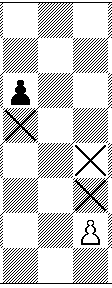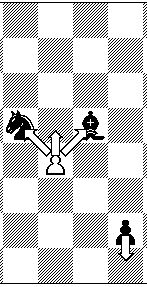 . .
. .
The Pawn is the only piece that moves differently from how it captures. The pawn, like the foot-soldier in war, marches forward one square at a time. Unlike the other pieces, the pawn can NEVER retreat. Pawn that have not yet moves have the option of beginning their forward journey with a double move two-squares forward. The pawns may not jump other pieces or pawns.
The pawn captures differently from how it moves. The pawn captures diagonally ONLY one square ahead, as if it were fighting on its side with a short sword.
 . .
. .
In the first diagram, the white pawn can move to any of the squares marked with an "X" By contrast, the black pawn, having already moved, has only one option.
In the second diagram, the white pawn can move straight ahead, or else capture the black knight or the black bishop. Meanwhile, the black pawn is about to move to the end of the board. When a pawn reaches the last rank, it becomes another piece! In most situations, it will become a queen; you may not leave it as a pawn and you may not promote it into a king. As a result of pawn promotion, it is possible to have many queens on the board at the same time!
Capturing "En Passant"
The pawn is also able to capture in a most unusual way. This is one of the trickiest moves to learn and the single move that causes consternation among beginners. A small bit of history helps to introduce and to understand the en passant (French for "while passing") capture. During the early days of chess, pawns could only move a single square at a time. Several changes were introduced in Europe to speed up the game. One of these changes permitted pawns to move two squares if they had not yet moved.
But this rule change introduced an unfortunate situation. A pawn could now move all the way down the board to become a queen without the opponent's pawn ever having a chance to capture it. In the following diagram, it is white's move. When the White pawn moves forward two squares in a single move, the Black pawn on the neighboring file wants to be able to capture the pawn before the white pawn can advance further. The en passant rule applies here. For one move, AND ONE MOVE ONLY, the black pawn can respond by capturing the White pawn as if it had only moved a single square. To effect the capture, move the black pawn forward diagonally and remove the white pawn.

Note that only pawns can capture "en passant," and only a pawn on an adjacent file can capture in this way.